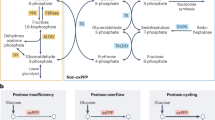Abstract
THE short survival of erythrocytes given by transfusion with stored donor blood is a problem of great current interest. The well-known steadily decreasing intensity of glycolysis in stored blood, despite excess of glucose, is easily explainable by a loss of adenosine triphosphate1. Gabrio et al. 1–3 have shown that addition of adenosine or inosine re-establishes the cell content of organic phosphate, increases the consumption of glucose, and thus the post-transfusion viability.
Similar content being viewed by others
References
Gabrio, B. W., et al., J. Biol. Chem., 215, 357 (1955).
Gabrio, B. W., et al., J. Clin. Invest., 34, 1509 (1955).
Gabrio, B. W., et al., J. Clin. Invest., 35, 657 (1956).
Chen, P. S., and Jørgensen, S., Acta Pharmacol. et Toxicol., 12, 1 (1956).
Jørgensen, S., and Chen, P. S., J. Clin. and Lab. Invest., 8, 145 (1956).
Overgaard-Hansen, K., Acta Pharmacol. et Toxicol. (in the press).
Author information
Authors and Affiliations
Rights and permissions
About this article
Cite this article
OVERGAARD-HANSEN, K., JØRGENSEN, S. & PRÆTORIUS, E. Rephosphorylation produced by Inosine and Adenosine of Adenosine Monophosphate and Adenosine Diphosphate in Human Erythrocytes. Nature 179, 152–153 (1957). https://doi.org/10.1038/179152a0
Issue Date:
DOI: https://doi.org/10.1038/179152a0
- Springer Nature Limited





